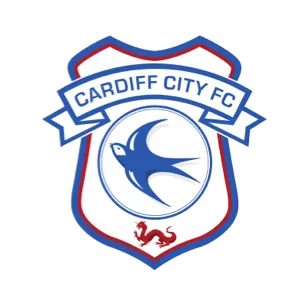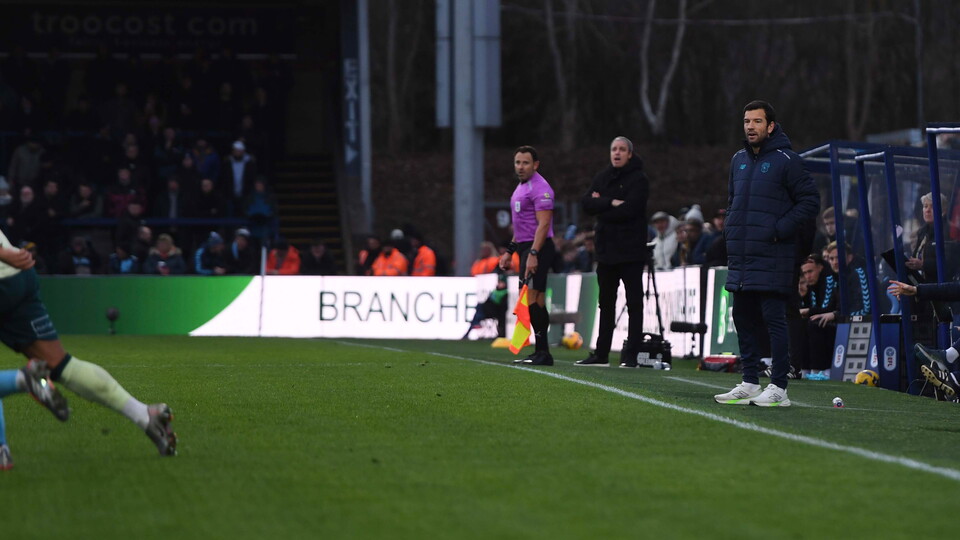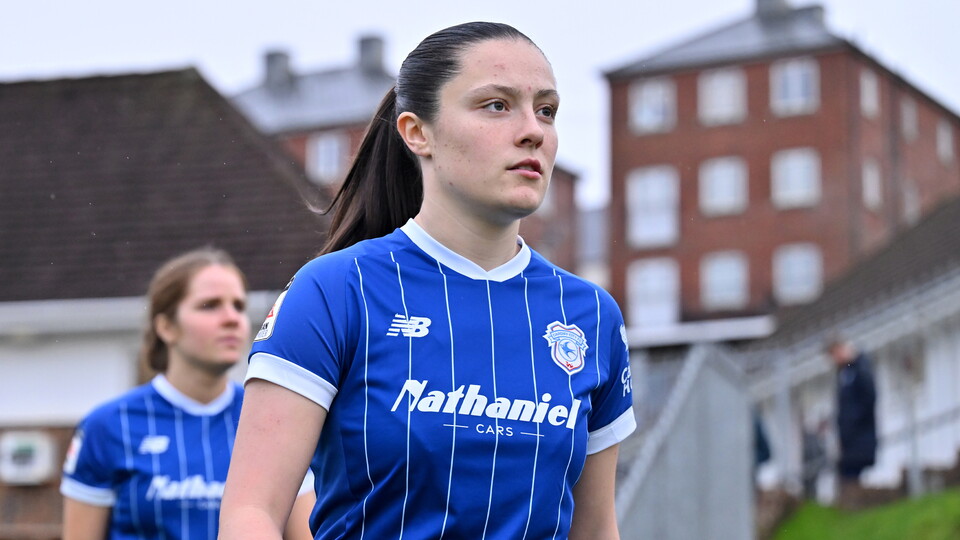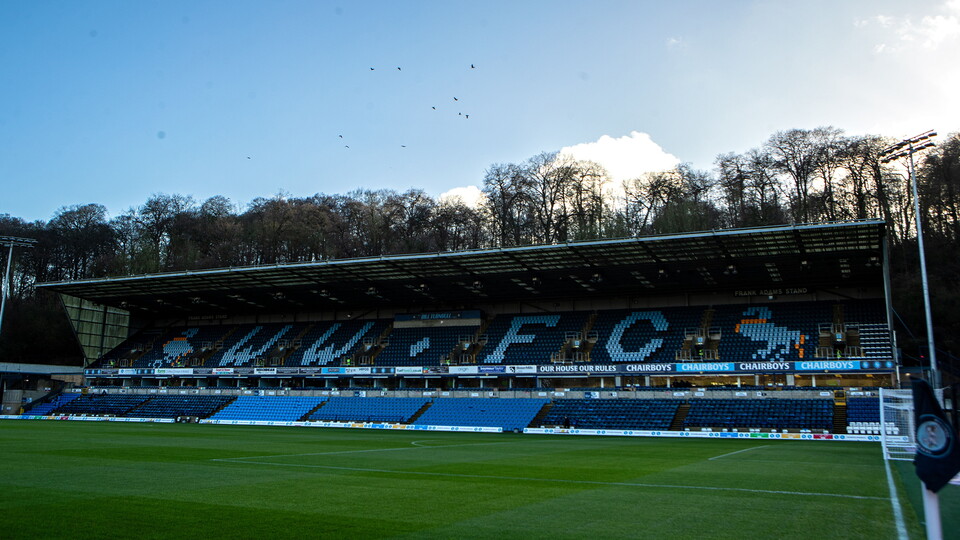From the 'roaring twenties' to a new world...
Fred Stewart once again set about improving the playing staff in readiness for elevation to Football League status, conducting the most expensive signing in City's history when securing Jimmy Gill from The Wednesday for £750. Gill would go on to repay that investment many times over by appearing in 184 league matches and scoring 83 goals during his six seasons at the Club.
On August 30, 1920, City played their first Football League match at Ninian Park when 25,000 watched Clapton Orient force a 0-0 draw. Home supporters did not have long to wait for a victory though, as it came just five days later when 23,000 fans roared their favourites to a 3-0 win over Stockport County. Arthur Cashmore netted twice in that one (his first the opening league goal at Ninian Park), and Billy Grimshaw grabbed the other. In November, Stewart went back to The Wednesday and set a record fee for a full back when he paid £3,500 for thirty-two-year-old Jimmy Blair.
Stewart's side proved more than a match for most of the teams in the division and they won promotion to the top flight at the first attempt in front of average crowds of over 28,000. In fact, champions Birmingham City only pipped City to the title by virtue of better goal average. Cardiff also had an excellent run in the FA Cup, beating Sunderland, Brighton and Southampton away before meeting Chelsea at Ninian Park in round four. A crowd of 50,000 saw Cashmore give City a 1-0 win to set up a semi-final tie with fellow Second Division side Wolverhampton Wanderers.
The first game at Anfield ended in a 0-0 draw, but was notable because it was the first occasion that reigning monarchs, King George V and Queen Mary, had attended a football match. The replay took place at Old Trafford in front of 74,000 fans, but a Fred Keenor penalty was not enough and City bowed out with a 2-1 defeat.
, shake hands before kick-off at Anfield, 19 March 1921.Val Gregory and Wolves' Charlie BrittanCity's
Cardiff now found themselves in Division One after just one season in the Football League. Stewart recruited a number of players including Jimmy Nelson from Belfast Crusaders, but his side had to wait until the seventh game of the season before recording a first victory. Middlesbrough were the victims at Ninian Park and City won 3-1 with Jimmy Gill netting twice and Harry Nash adding the third. The north-easterners were top of Division One at the time while City were bottom of the division after six straight defeats.
On January 21, 1922, Len Davies struck City's first Football League hat-trick in a 6-3 win over Bradford City, and the first season in Division One proved so successful that nineteen victories in forty-two games left City in fourth position despite that poor start. Manager Stewart was forced to use no less than thirty players during that first season, mainly as a result of established team members being away on international duty. This was clearly evident in the 1922-23 season when, on April 14, no less than six Cardiff City players were absent representing their countries. Playing in the Wales v Ireland match at Wrexham were Keenor, Davies and Jack Evans, while the Irish side included Tom Farquharson and Bert Smith. Blair was left back for Scotland against England at Hampden Park.
Without these players, City took on Sheffield United and beat them 1-0 at Ninian Park thanks to a Joe Clennell goal.
Season 1923-24 proved to be the best ever in the league for City and they came to the final Saturday one point ahead of second-placed Huddersfield Town. The Yorkshiremen were 3-0 winners at home to Nottingham Forest, leaving City requiring a victory at Birmingham City to secure the Division One title. With the score at 0-0, City were awarded a penalty but the normally reliable Davies shot straight at the Birmingham keeper. The game ended 0-0 and City lost the title on a goal average of 0.024! No other side would ever lose out by so narrow a margin.
The following year brought about the Club's first appearance at Wembley. It took three games to dispose of Darlington in the first round, and Fulham were dispatched 1-0 at Ninian Park in round two.The Bluebirds then travelled to Meadow Lane and beat Notts County 2-0 before knocking out Leicester City in thrilling fashion. With the scores locked at 1-1, Willie Davies scored the winner direct from a corner with the last kick of the match.
Blackburn Rovers were Cardiff's tough opponents in the semi-final, but City raced into a three-goal lead. Rovers pulled one back, but the Bluebirds were on the way to Wembley. Sheffield United were four times winners of the famous trophy and made it five when a tragic error by wing half Harry Wake let in England international Fred Tunstall for the only goal of the game.
Incidentally, Jimmy Nelson became the first Cardiff City player to be sent off in a league match when he was dismissed in the opening game of 1925-26 at Maine Road in a 3-2 defeat to Manchester City. On New Year's Day 1926, the Bluebirds suffered their worst ever league defeat when old rivals Sheffield United won 11-2 at Bramall Lane. But it was not all gloom as City now had a record number of sixteen international players on the books. Nine had represented Wales, four had appeared for Scotland, and three turned out for Ireland. A fourth player, Tom Watson, was capped by Ireland before the end of the season.
The 1926-27 season was famous for City's cup triumph at Wembley but on the league scene there were many worrying aspects with the General Strike of 1926 being held responsible for keeping attendances down to the 14,000 level. City ended up fourteenth in Division One but they turned on the style in the FA Cup.
Aston Villa were beaten 2-1 in the Third Round at Ninian Park, and the long trip north-east to Darlington was made worthwhile with a 2-0 success. Fred Keenor had suffered injuries and a loss of form but he was recalled for the fifth round tie at Bolton Wanderers and was inspirational in another 2-0 win.
Division Two promotion challengers Chelsea were next up for the Bluebirds and a crowd of 70,184 were at Stamford Bridge to see the sides draw 0-0. The midweek replay brought a further 47,853 to Ninian Park for a match that was to ultimately lead to a change in the laws of the game. City led 2-0 through Sammy Irving and Len Davies when Chelsea were awarded a penalty. Andy Wilson stepped up to take the spot-kick and City keeper Tom Farquharson retreated into the back of his goal. As Wilson ran up to kick the ball, Farquharson rushed out of the goal and blocked the ball on the six-yard line. The law was subsequently changed to make sure that the goalkeeper stayed on his line until the kick had been taken. Chelsea eventually equalised, but Hughie Ferguson netted the winner from another penalty. Reading were beaten 3-0 at Molineux in the semi-final and the Bluebirds were going back to Wembley.
On St. George's Day, April 23, 1927,the F.A. Cup was taken out of England for the first and only time when Cardiff City beat Arsenal 1-0 with a goal from Hughie Ferguson. On the wing for City was nineteen-year-old Ernie Curtis who was the youngest player to appear in a final at that time. Skipper Fred Keenor (below) received the trophy from King George V just seven years after Cardiff City had entered the Football League. It was the first cup final to be broadcast live on the radio.
Fred Keenor holds the F.A. Cup aloft following City's famous 1927 win at Wembley
F.A. Cup joy didn't signal the end of City's cup exploits that year either, for they also won the Welsh Cup by defeating Rhyl 2-0, and would go on to win the Charity Shield after beating Corinthians 2-1 at Stamford Bridge. The following season gave no hint of what was in store as City finished the season in sixth place, but in 1929 the Bluebirds were relegated despite having the least number of goals scored against them in the division.
City lasted two seasons in Division Two before slipping down to Division Three (South) in 1931 with only eight victories from forty-two games. During a dismal time in the lowest division, City posted their record league score when they swamped Thames 9-2 in February, 1932. Walter Robbins slammed five of the goals and there was one each for Jim McCambridge, Leslie Jones and Albert Keating (the ninth was an own goal). Scorer of one of Thames' goals was former City favourite, Len Davies. Results, however, continued to be poor and in May 1933, Fred Stewart's resignation was accepted. He had been in control for twenty-two years.
Bartley Wilson took over from Stewart for most of an unhappy season before giving control to Ben Watts-Jones in March 1934, but City were forced to apply for re-election after finishing bottom of the division. Watts-Jones remained in charge for only three years until replaced by Bill Jennings, a former Welsh international who had been brought to the club originally as trainer.
To add to the Club's woes, in January 1937 the centre stand at Ninian Park was destroyed by fire. But there were signs that the worst was over both on and off the field and an improvement in results over the next two seasons brought the fans back to Ninian Park in increasing numbers. The 1938-39 season saw the debut of Billy Baker, a resourceful wing half who would be a prominent member of future City sides, but a final position of thirteenth in the division was not thought to be good enough by new chairman Herbert Merrett, and he appointed Cyril Spiers (below) as secretary-manager to replace Jennings for the 1939-40 season.
Spiers set about changing the personnel, bringing in a number of new faces including inside forward Trevor Morris from Ipswich Town and also amateur centre forward Wilf Wooller, a Welsh rugby international who was also to captain Glamorgan at cricket.
Cyril Spiers
But of course, all these events were overshadowed by the Second World War in Europe of 1939-1945. The Football League was suspended in September 1939 and didn't restart until the 1946-47 season.
CLICK HERE FOR THE NEXT CHAPTER!
On August 30, 1920, City played their first Football League match at Ninian Park when 25,000 watched Clapton Orient force a 0-0 draw. Home supporters did not have long to wait for a victory though, as it came just five days later when 23,000 fans roared their favourites to a 3-0 win over Stockport County. Arthur Cashmore netted twice in that one (his first the opening league goal at Ninian Park), and Billy Grimshaw grabbed the other. In November, Stewart went back to The Wednesday and set a record fee for a full back when he paid £3,500 for thirty-two-year-old Jimmy Blair.
Stewart's side proved more than a match for most of the teams in the division and they won promotion to the top flight at the first attempt in front of average crowds of over 28,000. In fact, champions Birmingham City only pipped City to the title by virtue of better goal average. Cardiff also had an excellent run in the FA Cup, beating Sunderland, Brighton and Southampton away before meeting Chelsea at Ninian Park in round four. A crowd of 50,000 saw Cashmore give City a 1-0 win to set up a semi-final tie with fellow Second Division side Wolverhampton Wanderers.
The first game at Anfield ended in a 0-0 draw, but was notable because it was the first occasion that reigning monarchs, King George V and Queen Mary, had attended a football match. The replay took place at Old Trafford in front of 74,000 fans, but a Fred Keenor penalty was not enough and City bowed out with a 2-1 defeat.
, shake hands before kick-off at Anfield, 19 March 1921.Val Gregory and Wolves' Charlie BrittanCity's
Cardiff now found themselves in Division One after just one season in the Football League. Stewart recruited a number of players including Jimmy Nelson from Belfast Crusaders, but his side had to wait until the seventh game of the season before recording a first victory. Middlesbrough were the victims at Ninian Park and City won 3-1 with Jimmy Gill netting twice and Harry Nash adding the third. The north-easterners were top of Division One at the time while City were bottom of the division after six straight defeats.
On January 21, 1922, Len Davies struck City's first Football League hat-trick in a 6-3 win over Bradford City, and the first season in Division One proved so successful that nineteen victories in forty-two games left City in fourth position despite that poor start. Manager Stewart was forced to use no less than thirty players during that first season, mainly as a result of established team members being away on international duty. This was clearly evident in the 1922-23 season when, on April 14, no less than six Cardiff City players were absent representing their countries. Playing in the Wales v Ireland match at Wrexham were Keenor, Davies and Jack Evans, while the Irish side included Tom Farquharson and Bert Smith. Blair was left back for Scotland against England at Hampden Park.
Without these players, City took on Sheffield United and beat them 1-0 at Ninian Park thanks to a Joe Clennell goal.
Season 1923-24 proved to be the best ever in the league for City and they came to the final Saturday one point ahead of second-placed Huddersfield Town. The Yorkshiremen were 3-0 winners at home to Nottingham Forest, leaving City requiring a victory at Birmingham City to secure the Division One title. With the score at 0-0, City were awarded a penalty but the normally reliable Davies shot straight at the Birmingham keeper. The game ended 0-0 and City lost the title on a goal average of 0.024! No other side would ever lose out by so narrow a margin.
The following year brought about the Club's first appearance at Wembley. It took three games to dispose of Darlington in the first round, and Fulham were dispatched 1-0 at Ninian Park in round two.The Bluebirds then travelled to Meadow Lane and beat Notts County 2-0 before knocking out Leicester City in thrilling fashion. With the scores locked at 1-1, Willie Davies scored the winner direct from a corner with the last kick of the match.
Blackburn Rovers were Cardiff's tough opponents in the semi-final, but City raced into a three-goal lead. Rovers pulled one back, but the Bluebirds were on the way to Wembley. Sheffield United were four times winners of the famous trophy and made it five when a tragic error by wing half Harry Wake let in England international Fred Tunstall for the only goal of the game.
Incidentally, Jimmy Nelson became the first Cardiff City player to be sent off in a league match when he was dismissed in the opening game of 1925-26 at Maine Road in a 3-2 defeat to Manchester City. On New Year's Day 1926, the Bluebirds suffered their worst ever league defeat when old rivals Sheffield United won 11-2 at Bramall Lane. But it was not all gloom as City now had a record number of sixteen international players on the books. Nine had represented Wales, four had appeared for Scotland, and three turned out for Ireland. A fourth player, Tom Watson, was capped by Ireland before the end of the season.
The 1926-27 season was famous for City's cup triumph at Wembley but on the league scene there were many worrying aspects with the General Strike of 1926 being held responsible for keeping attendances down to the 14,000 level. City ended up fourteenth in Division One but they turned on the style in the FA Cup.
Aston Villa were beaten 2-1 in the Third Round at Ninian Park, and the long trip north-east to Darlington was made worthwhile with a 2-0 success. Fred Keenor had suffered injuries and a loss of form but he was recalled for the fifth round tie at Bolton Wanderers and was inspirational in another 2-0 win.
Division Two promotion challengers Chelsea were next up for the Bluebirds and a crowd of 70,184 were at Stamford Bridge to see the sides draw 0-0. The midweek replay brought a further 47,853 to Ninian Park for a match that was to ultimately lead to a change in the laws of the game. City led 2-0 through Sammy Irving and Len Davies when Chelsea were awarded a penalty. Andy Wilson stepped up to take the spot-kick and City keeper Tom Farquharson retreated into the back of his goal. As Wilson ran up to kick the ball, Farquharson rushed out of the goal and blocked the ball on the six-yard line. The law was subsequently changed to make sure that the goalkeeper stayed on his line until the kick had been taken. Chelsea eventually equalised, but Hughie Ferguson netted the winner from another penalty. Reading were beaten 3-0 at Molineux in the semi-final and the Bluebirds were going back to Wembley.
On St. George's Day, April 23, 1927,the F.A. Cup was taken out of England for the first and only time when Cardiff City beat Arsenal 1-0 with a goal from Hughie Ferguson. On the wing for City was nineteen-year-old Ernie Curtis who was the youngest player to appear in a final at that time. Skipper Fred Keenor (below) received the trophy from King George V just seven years after Cardiff City had entered the Football League. It was the first cup final to be broadcast live on the radio.
Fred Keenor holds the F.A. Cup aloft following City's famous 1927 win at Wembley
F.A. Cup joy didn't signal the end of City's cup exploits that year either, for they also won the Welsh Cup by defeating Rhyl 2-0, and would go on to win the Charity Shield after beating Corinthians 2-1 at Stamford Bridge. The following season gave no hint of what was in store as City finished the season in sixth place, but in 1929 the Bluebirds were relegated despite having the least number of goals scored against them in the division.
City lasted two seasons in Division Two before slipping down to Division Three (South) in 1931 with only eight victories from forty-two games. During a dismal time in the lowest division, City posted their record league score when they swamped Thames 9-2 in February, 1932. Walter Robbins slammed five of the goals and there was one each for Jim McCambridge, Leslie Jones and Albert Keating (the ninth was an own goal). Scorer of one of Thames' goals was former City favourite, Len Davies. Results, however, continued to be poor and in May 1933, Fred Stewart's resignation was accepted. He had been in control for twenty-two years.
Bartley Wilson took over from Stewart for most of an unhappy season before giving control to Ben Watts-Jones in March 1934, but City were forced to apply for re-election after finishing bottom of the division. Watts-Jones remained in charge for only three years until replaced by Bill Jennings, a former Welsh international who had been brought to the club originally as trainer.
To add to the Club's woes, in January 1937 the centre stand at Ninian Park was destroyed by fire. But there were signs that the worst was over both on and off the field and an improvement in results over the next two seasons brought the fans back to Ninian Park in increasing numbers. The 1938-39 season saw the debut of Billy Baker, a resourceful wing half who would be a prominent member of future City sides, but a final position of thirteenth in the division was not thought to be good enough by new chairman Herbert Merrett, and he appointed Cyril Spiers (below) as secretary-manager to replace Jennings for the 1939-40 season.
Spiers set about changing the personnel, bringing in a number of new faces including inside forward Trevor Morris from Ipswich Town and also amateur centre forward Wilf Wooller, a Welsh rugby international who was also to captain Glamorgan at cricket.
Cyril Spiers
But of course, all these events were overshadowed by the Second World War in Europe of 1939-1945. The Football League was suspended in September 1939 and didn't restart until the 1946-47 season.
CLICK HERE FOR THE NEXT CHAPTER!









